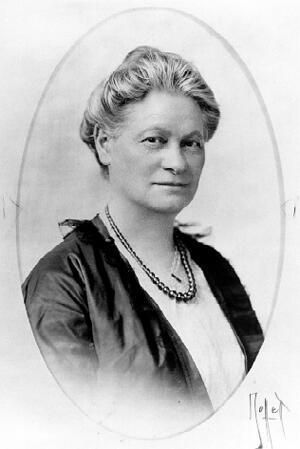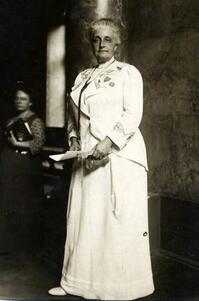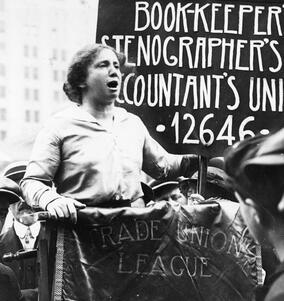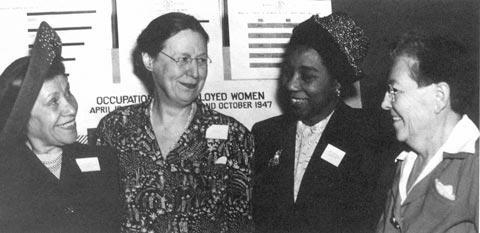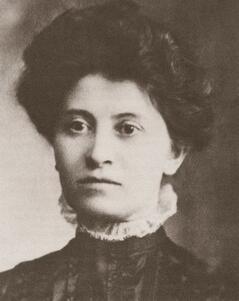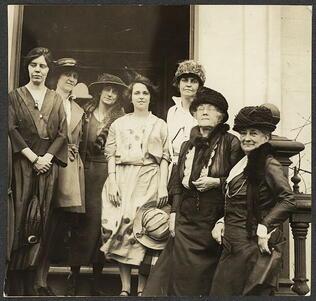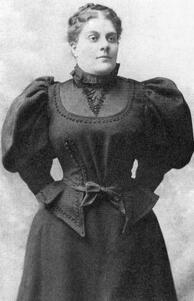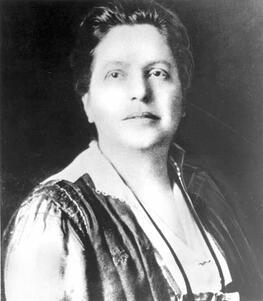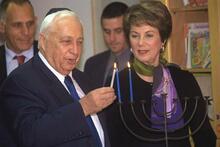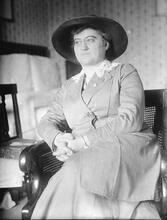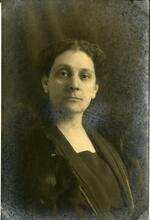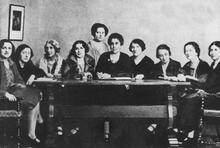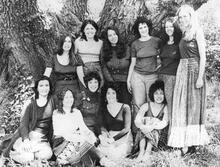Suffrage in the United States
Officers of the National Woman's Party in 1922.
Left to right: Alice Paul, Sue White, Florence Boeckel, Anita Pollitzer (center, holding hat), Mary Winsor, Sophie Meredith, and Mrs. Richard Wainwright.
Photo courtesy of the National Woman's Party and Wikimedia Commons.
Jewish women in the United States participated vigorously in a variety of mass social movements, including the long struggle for women’s enfranchisement. Individual American Jewish women had supported suffrage since the movement’s beginning in the mid-1800s. But the revitalization of the movement at the turn of the twentieth century, just when the American Jewish population was growing tremendously due to mass migration from eastern Europe, brought ever-increasing numbers of Jewish women (and many men) to the cause. Jewish suffragists confronted some resistance within their communities and some antisemitism and xenophobia within the suffrage movement itself. Still, by the last years of the campaign—which resulted in the Nineteenth Amendment giving women the right to vote—suffrage received overwhelming support from American Jews.
At the turn of the twentieth century, Jewish women in the United States participated vigorously in virtually all the era’s mass social movements, including the suffrage movement. Although individual American Jewish women had supported suffrage since the movement’s beginning in the mid-1800s, its revitalization during the 1890s—just when the American Jewish population was growing tremendously due to mass migration from eastern Europe—brought ever-increasing numbers of Jewish women (and many men) of all class, ethnic, national, and religious backgrounds to the cause. Jewish suffragists confronted some resistance within their communities and some antisemitism and xenophobia within the suffrage movement itself. Still, by the last years of the suffrage campaign—which resulted in the Nineteenth Amendment giving women the right to vote (passed 1919; ratified 1920)—the cause received overwhelming support from American Jews. Despite the significant role played by Jewish women and the important organizing work carried out by numerous Jewish women’s groups, however, American Jewish women have rarely appeared in the narratives produced by either the suffrage movement itself or by later historians.
American Jewish Women and Suffrage Organizations

Ernestine Rose (1810-1892) was a pro-suffrage, anti-slavery orator in the United States whose activism was recognized by contemporaries as a key contribution to the suffrage movement.
This photo is in the public domain.
The suffrage movement was never a unified force in the United States. Following the first women’s rights convention in Seneca Falls, New York, in 1848, which produced a “Declaration of Sentiments” that provocatively included a demand for women’s enfranchisement, numerous local, state, and quasi-national organizations sprang up to work on gaining women the right to vote, no easy feat at a time when women’s very presence in public was controversial in many quarters. One of the early prominent activists on the lecture circuit, often appearing with famed suffrage dynamo Susan B. Anthony, was Ernestine Rose, a rabbi’s daughter who was born in Poland but fled the strictures of her family for freethinking communities in Europe and the United States. Rose played a prominent role in the frequent women’s rights conventions in the antebellum era. Like many other early suffragists, she was also a committed abolitionist. Though she had renounced religious identity and affiliation in her own life, she defended Judaism and Jews in the wake of antisemitic attacks in the press. Just before leaving the United States for England in 1869, she helped oversee the long but ultimately successful campaign to secure married women’s property rights in New York, which she and other early activists saw as equally important as enfranchisement in assuring women equal rights.
Following the Civil War, the suffrage movement painfully split over the question of whether to support the Fifteenth Amendment, which granted African American men the right to vote but not women. Individual Jewish women joined the two major suffrage groups, but divisions hampered progress and few victories occurred for several decades. The merger of these groups into the National American Woman Suffrage Association (NAWSA) in 1890 ushered in a new era of activism that finally began to make inroads, particularly in the western states. Even though the very idea of women’s enfranchisement still struck many as radical, the obvious respectability of the largely middle-class, white women who filled NAWSA’s ranks made it an attractive organization for the many Jewish women who had either already acculturated to American gender norms or were interested in doing so as a way to leave their immigrant status behind them. Traditions of Jewish women’s public activity in both eastern and western Europe also contributed to the widespread Jewish interest in the suffrage movement.
Prominent American Jewish women like Hannah Greenebaum Solomon, first president of the National Council of Jewish Women (1893), and Maud Nathan, already involved in women’s issues through her work in the National Consumers’ League (1899), joined Progressive Era activists of all stripes in their belief that sorely needed reforms could only be achieved once women had the vote. They argued that women’s responsibility for home and family did not stop at the threshold of their private households but instead extended into the wider world. Suffrage would enable women to bring their special roles as mothers to bear on improving the state of public affairs. Nathan became a prominent member of NAWSA and perhaps the best known Jewish suffragist in the United States. She wrote countless columns and letters to editors, gave speeches to both Jewish and general audiences, and took great care to dress well and present an appearance of unimpeachable dignity and womanliness as part of her strategy for winning support. Nathan and Solomon also became involved in the International Woman Suffrage Alliance (IWSA), founded in 1904 as an offshoot of the International Council of Women (1888). They each attended multiple international conferences, with Nathan often serving as a parliamentarian at the meetings due to her facility in multiple languages. At these conventions they met Jewish suffragists in positions of leadership from other countries and forged connections to them as women, Jews, and activists.
Working-class women were less interested in the maternalist arguments of NAWSA and IWSA, though they sometimes cooperated with both groups, and more committed to using the vote as a tool to achieve better pay and conditions in an industrializing world that brutalized workers. Jewish labor leaders such as Rose Schneiderman and Pauline Newman, both immigrants from eastern Europe, joined the suffrage movement as part of their efforts to organize working women. They worked with cross-class organizations like the Women’s Trade Union League (1903) to link suffrage and labor. Schneiderman and Newman addressed crowds of Jewish workers in Yiddish and at various points worked as paid organizers for NAWSA. Other Jewish labor leaders, such as Jennie Matyas, seized every opportunity for converting women workers to the cause. Matyas was frequently arrested for participating in strikes and other labor actions and always took suffrage literature with her to distribute in jail. Socialist women, a minority but influential group in American urban centers during the early twentieth century, also supported enfranchisement, though they saw the standard suffrage organizations as hopelessly bourgeois and unresponsive to workers’ needs. For a time, Theresa Serber Malkiel ran a socialist suffrage group in New York that conducted its affairs primarily in Yiddish to best serve its largely Jewish membership. After the international socialist movement decided that formal support for suffrage contradicted the prioritization of class interests, Malkiel dissolved the group, but, like most other socialist Jewish women in the United States, she continued to support women’s enfranchisement.
The suffrage movement finally gained momentum starting in 1910. Over the next few years, Washington, California, Arizona, Kansas, Oregon, Montana, and Nevada all gave women the right to vote, with Jewish women like Selina Solomons in California and Felice Cohn in Nevada playing prominent roles in the campaigns. For some activists, however, particularly younger women, NAWSA had become a staid organization whose social conservatism impeded progress. These women were drawn to the new National Woman’s Party (NWP), led by Alice Paul, who had participated in the more militant suffrage movement in England. While NAWSA president and master strategist Carrie Chapman Catt developed what she called a “winning plan” to encourage both state-by-state and national suffrage campaigns, NWP focused almost entirely on a federal amendment to the Constitution. NWP members picketed the White House and staged hunger strikes when they were arrested, echoing British suffrage tactics. For some Jewish women, the greater militancy and immediacy of NWP’s demands proved appealing. Caroline Katzenstein, Rebecca Hourwich Reyher, and Anita Pollitzer, among others, worked closely with Alice Paul. All were young professionals eager to see change in women’s legal and economic status in addition to their voting rights. Unlike most NAWSA members, who viewed World War I as an opportunity to combine patriotic service with continuing arguments for the cause and therefore tempered their rhetoric during the war, most NWP members increased pressure on Congress and President Woodrow Wilson, who only came around to supporting suffrage reluctantly. In the end, the combination of NAWSA’s long-term strategy and NWP’s more radical activism helped turn suffrage into a mass movement that finally succeeded after the war ended.
Challenges to American Jewish Women’s Suffrage Activism
While Ernestine Rose, Maud Nathan, Rose Schneiderman, Anita Pollitzer, and many other Jewish women played important roles as individuals in the American suffrage movement, the major American Jewish women’s groups were slow to endorse enfranchisement. Neither the Ladies Auxiliary of the socialist Workmen’s Circle (1905) nor Hadassah (1912) formally endorsed suffrage until 1917 and the National Council of Jewish Women never did so, despite the fact that the majority of these groups’ members believed women should have the right to vote. Individual chapters of all these organizations held local programs in favor of suffrage, including in the South, where Jewish women were sometimes more likely to come out in favor of enfranchisement than other Southern women’s groups that feared African American women gaining the right to vote. The National Council of Jewish Women frequently invited suffrage luminaries like Carrie Chapman Catt to address its triennial meetings, yet as late as 1917, despite assurances to Catt by NCJW leaders and suffrage stalwarts Hannah Greenebaum Solomon and Rebekah Kohut, the proposal to endorse women’s enfranchisement was defeated once again. It is possible that these groups—Hadassah and the National Council of Jewish Women, in particular—simply could not reconcile such an overtly political statement with their missions, and the women of the Workmen’s Circle might have been honoring the international socialist movement’s dictates to prioritize class interests. However, the xenophobia and even antisemitism endemic to the mainstream suffrage movement may also have left Jewish women’s groups cautious about formal endorsements or affiliations.
Antisemitism in the suffrage movement, and in the women’s movement writ large, was as old as the movements themselves. Ernestine Rose had denounced her antisemitic critics during the antebellum period, and the rise of antisemitism in the wake of the mass migration of eastern European Jews influenced the movement. Activist leaders like Matilda Joslyn Gage and Anna Howard Shaw were not shy in expressing their distaste for Jews and Judaism, while Elizabeth Cady Stanton caused a sensation with her 1895 Woman’s Bible, which blamed women’s historical oppression on Judaism and Christianity. The mainstream suffrage movement distanced itself from the anticlerical Woman’s Bible, but Stanton remained unapologetic and dismissed the concerns of a delegation of Jewish women who protested the many blatantly antisemitic passages in her tome.
The turn of the twentieth century brought little improvement. Part of NAWSA and NWP’s strategy for appealing to Southern women, who had been slower to embrace the cause, was to make an explicitly racist appeal to white women that they deserved the vote far more than the black men they saw as inferior. The success of this argument encouraged the suffrage movement to take a similar tack in denouncing a system that allowed uneducated immigrant men to become voting citizens within a few years of coming to the United States while “American” women were deprived of suffrage. This racist and xenophobic sentiment was widely shared by suffragists, including Catt (who later regretted her rhetoric and worked on behalf of Jews endangered by Nazism) and Harriet Stanton Blatch, Elizabeth Cady Stanton’s daughter. Alice Paul’s antisemitic views were so widely acknowledged that decades later her former suffrage colleagues were still trying to make sense of the close relationships she had with Jewish activists such as Rebecca Hourwich Reyher and Anita Pollitzer. When a series of 1915 suffrage referenda in states with large Jewish populations, including Massachusetts, New York, New Jersey, and Pennsylvania, failed, Blatch and others pointed a finger at Jewish and other immigrant communities for the deeply disappointing defeats. Even Henry Street Settlement founder Lillian Wald, not known for identifying deeply with her Jewish roots, felt moved to counter Blatch’s denunciation by pointing out that the heavily Jewish districts of New York City provided the most votes for the referendum in the state. Like Jewish women, Jewish men tended to promote the cause, and their support helped turn the tide when New York finally enfranchised women in 1917 after a second, successful referendum.
Though most American Jews were favorably disposed toward votes for women, there was no unanimity, and debates over suffrage raged in the American Jewish press. A 1912 suffrage symposium in The American Hebrew, a widely read newspaper with a target audience of acculturated Jews, gave ample space to women writing on both sides of the debate. To the great amusement of many observers, the most vehement denunciation of enfranchisement came from Annie Nathan Meyer, who was none other than prominent suffragist Maud Nathan’s sister. Meyer dismissed the dirty world of politics as no place for women and decried the idea that women’s presence in the public arena would purify it or fix all the problems of the day. Meyer was among the founders of Barnard College and fancied herself a professional writer; she fit the mold of the liberated New Woman who supported suffrage as a matter of course. Yet she was nearly as visible an “anti” as her sister was a “pro”; she was certainly the best-known American Jewish woman to oppose the movement, and the National Association Opposed to Woman Suffrage counted her an important ambassador to the Jewish community. She may have genuinely believed that the suffrage movement was making promises it could not keep in terms of the effect of women’s votes on the state of the world, but the longstanding personal animosity and competition between the sisters probably also contributed to Meyer’s reactionary anti-suffrage stance. The fact that she joined the League of Women Voters soon after the Nineteenth Amendment was ratified is cause for skepticism about her anti-suffrage stance.
The American Jewish Community and Suffrage
While The American Hebrew and Jewish communal organizations scrupulously gave space to arguments on both sides of the debate, American Jews generally supported the suffrage movement. Both the English and Yiddish American Jewish press regularly ran articles about enfranchisement, with the vast majority expressing strong support. This was true even of the more conservative, religiously traditional Yiddish periodicals, which cited the Biblical precedents of Deborah and Esther as role models for Jewish women’s involvement in public affairs. Jewish activists like Maud Nathan and Rebekah Kohut also typically focused on historical examples of Jewish women when addressing Jewish audiences, which they and many others did in venues from lecture halls to synagogue pulpits to National Council of Jewish Women conventions. Working-class Jewish activists such as Rose Schneiderman and Pauline Newman also drew on Jewish traditions of social justice when organizing Jewish workers’ support for suffrage. Yiddish newspapers aimed at socialist readers encouraged support for suffrage as part of a larger working-class solidarity, while those read primarily by more traditional readers stressed the positive role wives and mothers would play as voters.
Such arguments appealed to American Jewish men as well as women, critically important given that women could not vote to give themselves the vote—only men could do so. Frederick Nathan, Maud’s husband, served as an officer in the Men’s League for Woman Suffrage (1907) and, though sick and quite frail, made his way to the polls in a wheelchair to vote in favor of enfranchisement in both the 1915 and 1917 New York state referenda. Louis Brandeis, one of the best-known Jewish men in the United States in the early twentieth century, supported suffrage and famously said so at a Zionist convention just before his appointment to the Supreme Court in 1915. Socialist Meyer London, who represented the heavily Jewish Lower East Side in Congress, regularly demanded women’s enfranchisement when making speeches in the House of Representatives. Large percentages of male voters in the heavily Jewish Lower East Side and Harlem voted for suffrage in 1915 and 1917.
In their roles as religious leaders, rabbis, too, played an important part in swaying the American Jewish community toward favoring voting rights for women. While not all American Jews cared what rabbis thought, the suffrage movement had sought clerical approval for decades and rabbinical endorsement was important to the cause. Rabbis Joseph Krauskopf and W. H. Fineshriber were among those who not only made their personal support of suffrage known but also invited activists like Maud Nathan and Hannah Greenebaum Solomon to address their congregations at a time when seeing a woman speak from a synagogue pulpit still came as something of a shock. Rabbi Edward Israel participated in suffrage marches in Baltimore and Washington, D.C. In San Francisco, Rabbi Martin A. Meyer provoked the ire of his more ambivalent congregants when he delivered several pro-suffrage sermons and taught the girls in his confirmation class about the importance of voting during the California campaign. Rabbi Stephen S. Wise, a leading figure of American Jewry, also lent his considerable influence to supporting enfranchisement. Many of these rabbis identified with the Reform movement, which formally endorsed suffrage in 1917, but rabbis from other denominations also favored women’s right to vote. In 1919 the Orthodox Rabbi Jacob Levinson published The Equality of Women from the Viewpoint of Halakhah, which concluded that suffrage was permissible and even desirable, given the important role women had played in many episodes of Jewish history.
The Aftermath of the Nineteenth Amendment in the American Jewish Community
In the immediate aftermath of the passage and ratification of the Nineteenth Amendment, Jewish suffragists rejoiced. Even Jewish women who had not been particularly activist began to vote with enthusiasm, as seen in a wave of new Socialist Party registrants in New York, most of whom were Jewish women. Despite having never formally endorsed suffrage, the National Council of Jewish Women joined other major women’s organizations in the new Women’s Joint Congressional Committee (1920) to try to parlay women’s enfranchisement into social welfare policy and reform, illustrating how much support there had been within the group for women’s political participation all along. Many newly enfranchised Jewish women joined their local League of Women Voters (1920) chapters, and organizations like the Chicago Conference of Jewish Women’s Organizations worked closely with the League of Women Voters to encourage women voters’ turnout. Even former anti-suffragists like Annie Nathan Meyer accepted the new reality and worked on voter education initiatives.
Just as some Jewish suffragists had found NAWSA too conservative for their liking and opted to work with the NWP instead, some Jewish women preferred to keep working with the NWP rather than the League of Women Voters. The League of Women Voters developed a maternalist platform encompassing such issues as child welfare and peace, but the NWP focused narrowly on an Equal Rights Amendment, which it first brought before Congress in 1923. Rebecca Hourwich Reyher and Anita Pollitzer, among other Jewish women, remained NWP stalwarts. Reyher opened an NWP headquarters in New York, while Pollitzer lobbied Congress to pass the Equal Rights Amendment. Most other American women’s groups, including the National Council of Jewish Women, long opposed the Equal Rights Amendment because it threatened the protective legislation for working women favored by the labor movement. Pollitzer and Pauline Newman, though always personally cordial, clashed repeatedly in public debates over the Equal Rights Amendment.
These ideological differences among former suffragists interested some American Jewish women, but many turned their attention to applying their new rights to their communal status. As soon as they won the vote, sisterhood members of The Temple in Atlanta successfully insisted on representation on the synagogue board. Temple Beth-El in Providence enlarged its board in 1921 to allow women to vote and hold office. Similar steps were taken by synagogues of all denominations across the country in the wake of the ratification of the Nineteenth Amendment. Jewish women’s organizations, including groups such as the National Federation of Temple Sisterhoods (1913, now Women of Reform Judaism), the National Women’s League of the United Synagogue (1918, now the Women’s League for Conservative Judaism), and the Women’s Branch of the Orthodox Union (1923-2018, replaced by Orthodox Union Women’s Initiative) increased their direct political work and lobbying efforts once their members were all voters, demanding—and receiving—higher status and more power. Suffrage could not solve all of Jewish women’s particular problems any more than enfranchisement could solve all of American women’s general problems, but the passage of the Nineteenth Amendment was the culmination of decades of women’s political engagement that inspired Jewish women to further activism both inside and outside the American Jewish community.
Anderson, Bonnie S. The Rabbi’s Atheist Daughter: Ernestine Rose, International Feminist Pioneer. New York: Oxford University Press, 2017.
DuBois, Ellen Carol. “Woman Suffrage and the Left: An International Socialist-Feminist Perspective.” New Left Review 186 (March-April 1991): 20-44.
Goodier, Susan. No Votes for Women: The New York State Anti-Suffrage Movement. Urbana: University of Illinois Press, 2013.
Klapper, Melissa R. Ballots, Babies, and Banners of Peace: American Jewish Women’s Activism, 1890-1940. New York: NYU Press, 2013.
Kuzmack, Linda Gordon. Woman’s Cause: The Jewish Woman’s Movement in England and the United States, 1881-1933. Columbus: Ohio State University Press, 1990.
Lerner, Elinor. “Jewish Involvement in the New York City Suffrage Movement.” American Jewish History 52 (June 1981): 442-261.
Nathan, Maud. Once Upon a Time and Today. New York: G.P. Putnam, 1933.
Reyher, Rebecca Hourwich. “Search and Struggle for Equality and Independence.” Oral history conducted by Amelia R. Fry and Fern Ingersoll for the Regional Oral History Office, Bancroft Library, University of California, Berkeley, 1977. https://oac.cdlib.org/ark:/13030/kt6x0nb1ts/?brand=oac4
Rogow, Faith. Gone to Another Meeting: The National Council of Jewish Women, 1893-1993. Tuscaloosa, AL: University of Alabama Press, 1993.
Solomon, Hannah Greenebaum. Fabric of My Life: The Story of a Social Pioneer. New York: Bloch, 1946.


